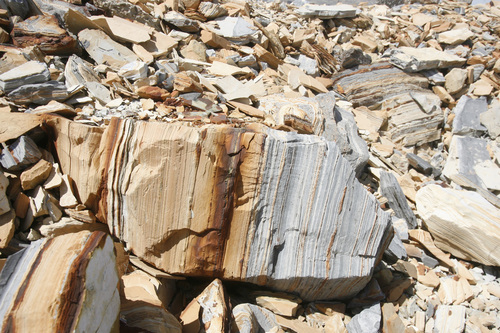This is an archived article that was published on sltrib.com in 2014, and information in the article may be outdated. It is provided only for personal research purposes and may not be reprinted.
Utah has a new player looking to unlock the Uinta Basin's Eocene bounty of oil shale.
London-based TomCo Energy on Monday filed papers with the Utah Division of Oil, Gas and Mining proposing large mining operations on state land in the southeast corner of Uintah County.
TomCo licensed a new extraction technology from Red Leaf Resources, which has recently lined up its permits and expects to begin mining Uinta Basin shale this spring. If successful, Red Leaf's mine near Seep Ridge would be the nation's first commercial oil shale operation after a century of attempts.
Red Leaf's EcoShale method places hydrocarbon-bearing ore in lined pits where it is cooked at 725 degrees for 210 days. The process converts, or "retorts," solid kerogen — found in a slice of the Green River Formation that geologists call the Mahogany Ledge — into liquid petroleum.
"It is more environmentally friendly, requires less water, has less emissions and the quality of the oil is better," said TomCo publicist Ed Portman, comparing the EcoShale process with an established shale retort process proposed elsewhere in the basin.
Enefit American Oil, a state-owned Estonian company, hopes to operate such a retort plant to work shale extracted on private land not far from TomCo's leasehold near the Colorado state line.
But environmentalists vow to fight development of Utah's vast oil shale resource, which some believe is an unacceptably dirty fossil fuel source regardless of how it's processed.
This is because the shale must be strip mined, then heated to high temperatures, thus spewing far more greenhouse gases than conventional oil extraction. The EcoShale method could contaminate groundwater, according to environmental groups that intend to appeal the state Division of Water Quality's recent Red Leaf permit.
"They aren't taking concerns seriously," said Rob Dubuc, an attorney with Western Resource Advocates. "They say there is groundwater, but it's not important groundwater worth protecting, and they are not requiring adequate monitoring."
Groundwater monitoring is essential for gauging this technology's capacity for damaging the environment, Dubuc said.
TomCo's two Utah leases cover nearly 3,000 acres belonging to the state School and Institutional Trust Lands Administration (SITLA). The proposal filed with mining regulators Monday targets a 1,280-acre lease called the Holliday Block, about 15 miles east of Red Leaf's mine, also on SITLA land. Portman said this lease could yield up to 126 million barrels of oil.
TomCo officials said they were inspired to move on their Utah leases by Red Leaf, which they believe is pioneering a way through an unfamiliar permitting process and proving up a promising technology.
"We are supportive of [TomCo] and encouraging them going forward," said Jeff Hartley, who manages Red Leaf's governmental affairs.
Under various agreements, 6 percent of TomCo's revenues would go to Red Leaf and 5 percent to SITLA, according to the publicly-traded company's investor presentations. Thanks to Utah's incentives for unconventional energy development, TomCo would get 75 percent of its state taxes refunded.
TomCo says it can reap 21 gallons of oil from each ton of ore and hopes to produce up to 9,800 barrels per day. The company has already secured permission to mine about 20 tons for testing and begun drilling in preparation for applying for a state groundwater permit.
But until the state sees how Red Leaf builds its proposed 150-foot-deep,10-acre retort pits and how they perform, Dubuc believes TomCo's mining application is premature.



